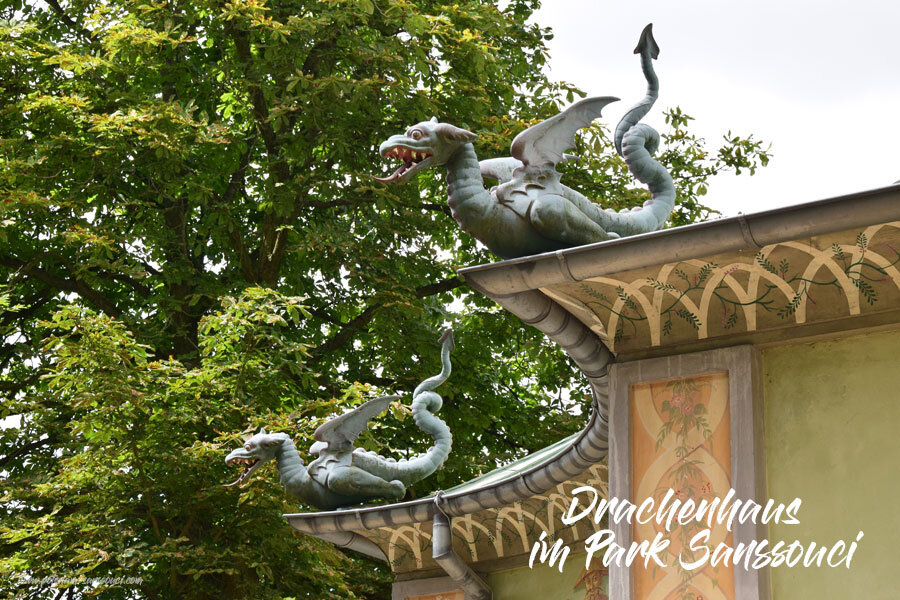
Dragon House in Sanssouci Park
The Dragon House on the Northern Edge of Sanssouci Park, built between 1770 and 1772 in Chinoiserie style, captivates with its gilded dragon decorations. Originally planned as a vintner’s quarters, it now serves as a restaurant and café, renowned for its historical ambiance and classical chamber music events.
Table of contents
Dragon House on the Northern Edge of Park Sanssouci in Chinoiserie Style
The Dragon House, constructed between 1770 and 1772 on the Bornstedt ridge at the northern edge of Park Sanssouci, is a typical example of Chinoiserie style. Designed by Carl von Gontard at the behest of Frederick II, the building was inspired by the Ta-Ho Pagoda from Canton, as described by William Chambers. The pagoda, named after the gilded dragons on its roof corners, was originally intended to house the vintner of the nearby vineyard and offers views of Sanssouci Palace. Over time, the Dragon House fell into disrepair and was repurposed as a coffeehouse at the turn of the century. In 1935, a kitchen was added. From 1996, the building was leased to Peter Hortig, and since 2012, it has been managed by his son Alexander as the “Restaurant & Café Drachenhaus.” Today, the Dragon House is a cherished venue for classical chamber music in a historic setting, where guests can enjoy a three-course candlelit dinner.
History of the Dragon House
In 1768, Frederick II received a request from a Rhineland grenadier wishing to establish a vineyard on Klausberg. By 1769, a 200-meter-long section of the southern slope had been terraced, but the vineyard failed, leading the grenadier to abandon the project. Instead, the king had peaches and azarole apples planted. The Dragon House was constructed in 1770, designed by Carl von Gontard and inspired by the Ta-Ho Pagoda from Canton, described by William Chambers in 1757. With gilded dragons on the roof corners, the building initially served as quarters for the grenadier. Beyond its decorative architecture, it was intended as a residence for the vintner of the vineyard established in 1769, though the vineyard was never fully utilized.
After the grenadier’s departure and poor harvests, the Dragon House was assigned in 1771 to the gamekeeper of the New Palace. Following Frederick II’s death, the Dragon House saw only sporadic use. To prevent its decay, it was restored in 1787 and subsequently inhabited by the caretakers of the nearby Belvedere. Constant usage necessitated modifications, as documented in an 1884 plan, which included an additional room, a laundry, and three stables.
The chinoiserie-style building underwent numerous restorations to preserve its decorative paintings and delicate architecture. It remains one of the last surviving examples of Frederick II’s fascination with Chinese-inspired architecture, based on designs by Sir William Chambers. Since 1934, it has been used as a gastronomic establishment, offering guests a historic atmosphere.

Dragon House: Architecture & Design
The Dragon House, built on an octagonal plan, was reduced to four tapering stories by Carl von Gontard. The wider ground floor, with concave walls, included a hallway, two rooms, and a kitchen. The three upper stories remained open and were not used as living spaces. The roof’s concave curves were adorned with sixteen gilded dragons and tassels. The original sheet metal dragons, crafted by sculptors Nathanael Eppen and Gerhard Buschmann, were replaced with replicas during 1904 restorations. The building was painted green, with ochre pilasters decorated with wave patterns and small floral bouquets, and Chinese heads placed above the window arches.
Restaurant & Café Dragon House
Open daily from 11:00 AM to 7:00 PM.
For more information, visit drachenhaus.de
Address
Maulbeerallee 4, 14469 Potsdam
Images
Frequently Asked Questions
What is the cost of visiting Sanssouci Park and Sanssouci Palace?
Sanssouci Park is free of charge, though a voluntary contribution to park maintenance is appreciated. You can enjoy guided tours and activities by choosing one of our partners' top offers. The best option for visiting Sanssouci Palace is the "Sanssouci+ Ticket" (including Sanssouci Palace), which grants one-time access to all* open palaces of the Prussian Palaces and Gardens Foundation Berlin-Brandenburg in Potsdam.
How many days should you plan for a visit to Potsdam?
Take your time to explore Potsdam. Plan a multi-day trip to experience the city at a relaxed pace. We have carefully selected the best hotels in Potsdam for your stay. Enjoy your visit!
Which sights should you not miss when visiting Potsdam?
Where can I park near Sanssouci Park?
For a safe arrival by car in Potsdam, we have compiled key information on the best parking lots and parking options around Sanssouci Palace and Sanssouci Park. Enjoy your time in Potsdam worry-free!
